Notre Dame couldn’t separate from Northern Illinois. While a fact check reveal there was some luck involved, the Huskies were just as efficient as the Irish, more explosive, and doubled up the 4-TD favorites in scoring chances created. The post-game win expectancy from SP+ reveals a coin-flip game – one that Marcus Freeman couldn’t afford to lose or even put in play with the 10th most talented team played the 124th (via the 247 talent composite).

I won’t beat you over the head with the bad numbers. You’ve seen by now how these NIU / Marshall / Stanford upsets have been surrendered disproportionally in Notre Dame Stadium than any other program over the last 2.2 seasons. This will be a shorter review than most, but will attempt to unpack what went so wrong (again) and what to monitor moving forward to an uncomfortable road game against an aggressive Purdue defense.
Red Flag #1: The passing offense
Riley Leonard’s placement here will not surprise anyone.
His average depth of target was below average at Duke too; his completion % over expected was not this poor.
Which gets to all the gross questions – why, is he hurt, etc. etc. https://t.co/phcAnENqSr
— Michael Bryan (@michaelbryanMB) September 10, 2024
The headline story from the loss has to be Riley Leonard and the passing attack issues. It would have been the biggest problem even before Leonard’s inexplicable, back-breaking interception late in the 4th quarter. That bad call, decision, and execution was worth -5.3 points per expected points added (EPA). It’s an inexact science trying to calculate the EPA of a single play but it at least gives us a sense of how horrific that play was in a tight contest.
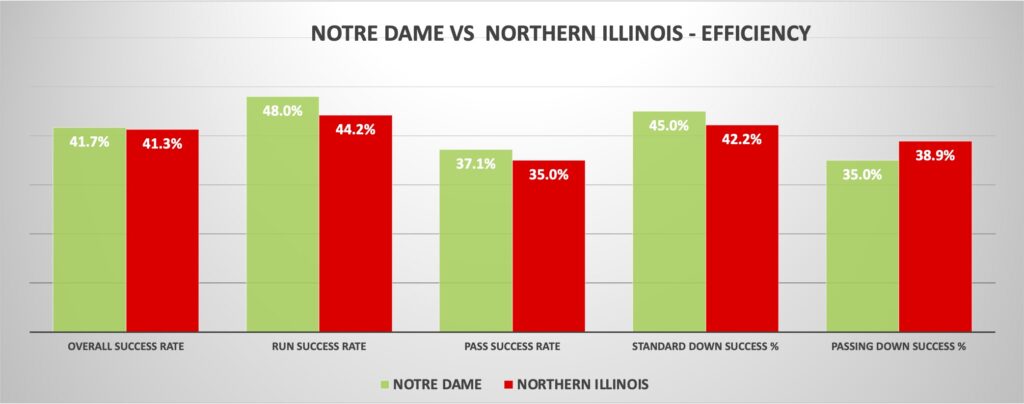
Even before that deciding interception, the Notre Dame passing attack still had negative EPA per play. Mike Denbrock’s gameplan seemed to be to simplify out-talent Northern Illinois on hard mode, barely leveraging motion or play action despite the lack of consistent efficiency throughout the game. A forgivable passing performance in College Station that was also inefficient and lacked explosive plays and separation suddenly looks a bit different when the same themes crop up against a MAC defense at home.
Play Action Rate vs. Pass Rate Over Expected
Notre Dame is last in the Power 4 in play action rate and ranks 133rd out of 134 among all FBS teams
Only James Madison has used play action at a lower rate pic.twitter.com/MJXeAykQ4H
— Notre Dame Football Stats & Analytics (@ND_FB_Analytics) September 11, 2024
The lone bright spot was Beaux Collins, who caught all five of his targets, each of which were successful plays. Unfortunately only one of catches went for longer than 10 yards, indicative of the overall lack of downfield attack. Collins is also where the good news stops. Jaden Greathouse saw nine targets but just two of those were successful plays, and he dropped Leonard’s lone accurate deep shot. Kris Mitchell targets were similarly inefficient, with two successful plays on eight targets.
Mitchell Evans did see an increase to 22 snaps, and the theoretical plan to bring him back slowly for the big games is probably out the window now that every game is a must-win.

Riley Leonard’s season-long passing chart via PFF
Riley Leonard played miserably after the opening drive, with a brutal combination of mental and physical errors (which may be due to the recently reported injury to his non-throwing shoulder / labrum). In addition to the accuracy issues, Leonard continues to miss the rare open receiver and too often run into miscommunication issues with his receivers.
Just to put a bow on it, Collins is in fact, running free down the sideline https://t.co/9ioWGWobVh pic.twitter.com/EneOdYcgPZ
— Greg Flammang (@greg2126) September 10, 2024
A common fan reaction to Leonard’s disastrous game was that the Irish staff has to stop taking in grad transfer QBs and re-treads. No question, Plan A should be to recruit and develop passers. But when the right move is to go to Plan B – and I think even in hindsight, taking Hartman and Leonard were the correct moves versus standing pat – maybe a more important question is why these sought-after QBs aren’t being put in situations to be successful.
Across the recent horrific losses there’s a common theme, which is an offense that has too many weak links and implodes on itself. The Stanford and NIU games had this in common – poor QB play, an offensive line not capable of mashing an inferior opponent, and receivers that can’t threaten defenses enough to make them pay for an aggressive approach.
I’m going to learn from the 2021 experience and quick post-game proclamations that the Notre Dame staff has to make a move to another QB. In that case, it was that Jack Coan was a terrible fit and the team had to turn to Drew Pyne or Tyler Buchner. And as it turned out, while Buchner’s legs were valuable, Coan was definitely the better QB and solution once the Irish figured out how to design an offense around their strengths and weaknesses (and there were good reasons not to turn to the backups).
We don’t know Leonard’s true health, or where the staff is with their assessments of Steve Angeli, Kenny Minchey, and CJ Carr. But Leonard’s struggles and injury combined with the staff’s lack of transparency puts tons of scenarios in play for the game in West Lafayette. Buckle up.
Red Flag #2: The defense
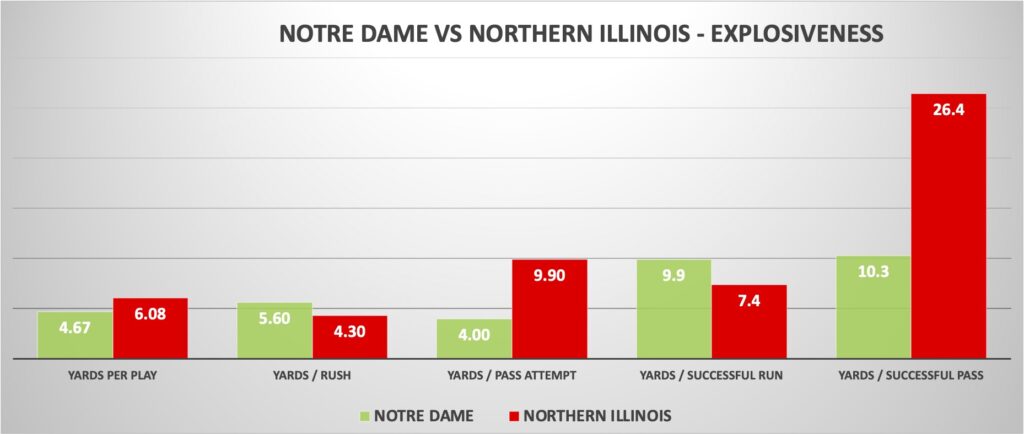
At first, I was tempted to lump the vast majority of blame on the offense. The Irish defense only allowed 16 points, and 7 of those came on a fluky 83-yard TD. For as bad as the rushing defense looked, the Huskies only ran for 4.3 yards per carry and had negative EPA on run plays (-0.04, a 42nd percentile performance via GameonPaper).
But as I dug in, this began to feel more and more like a poor effort and death by a thousand cuts in the 2nd half (after some large slashes defined the 1st half). As my friend Jamie Uyeyema immediately identified, Al Golden’s defense couldn’t sustain success and force 3rd and long situations. Positive 1st down performances were consistently followed by 2nd and long let-downs, leading NIU to an average 3rd down distance of 4.3 yards to convert.
ND lost to NIU because of their offense. No one can dispute that
The big failure on D after the 3 explosives allowed was on 2 and long (7+). Allowed 6.3 YPC, which was why NIU’s average 3rd down distance was 4.2 yards. NIU was 80% run on 2 and long, including 11 straight
— Jamie Uyeyama (@jamieuyeyama) September 8, 2024
It’s one thing to be caught off guard by runs on passing downs, but this is what Thomas Hammock’s team is known for! The Huskies were a top-20 team in rush rate over expected in 2023 and a bottom-20 team in pace. The classic underdog formula of running the ball, shortening the game, and not taking chances played right into NIU’s hands and it’s a glaring miss that the Irish couldn’t throw them off schedule.
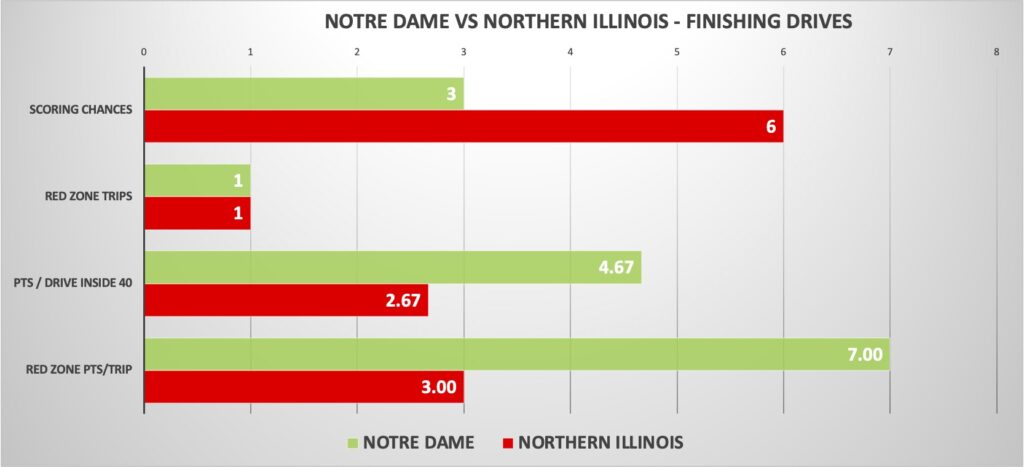
Notre Dame was also fortunate that NIU failed to convert scoring opportunities effectively (more charitably, you could say ND tightened up, but this week’s edition is not going to be charitable). Beyond the 80+ yard touchdown, the NIU scoring chances ended in four field goal attempts and a failed 4th down conversion. That’s more of what you’d expect from the Irish defense, but 8 of 10 NIU possessions going for 30 or more yards is a huge problem, especially when your offense can’t move the ball.
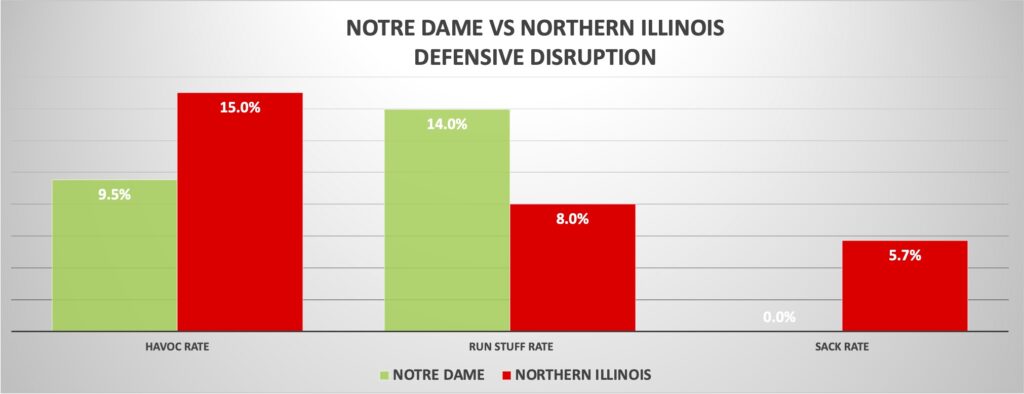
It’s too early to make declarative statements about the defense, but the lack of disruption is troubling. It’s one thing to bend but don’t break, creating enough negative plays to capitalize on. But the Irish defense slowly bled extra yards that were critical. They kept NIU from dangerous passing downs, ensured long fields for the ND offense (average starting field position the ND30, with a best starting field position of the ND39).

The Irish defensive profile above reflects these early trends – it’s a defense that has been fairly soft against the run, not disruptive, and will yield 3-4 yards with alarming frequency. The lack of explosive runs given up is great but has to be supplemented with some early down wins that force the passing downs that are the strength of the Irish defense.
Red Flag #3: Recalibrating the offensive floor and ceiling?

The radar chart above tells a grim story. Through two games the Notre Dame offense is good at one thing – explosive runs (again, shout-out to GameonPaper, which is adding new cool stuff weekly). Everything else? Not great!
PFF has ND RB Jeremiyah Love 6th in missed tackles forced with 15 on only 24 carries (1st has 21 more carries than him). Jadarian Price has 6 MTFs on only 12 carries. Have to get your playmakers the football more often
— Jamie Uyeyama (@jamieuyeyama) September 9, 2024
That’s what makes Notre Dame’s lack of touches for their emerging stars at running back even more puzzling. The Irish had an early down run rate of just 44%, despite being more efficient and explosive on the ground. If Leonard’s legs aren’t an option due to injury, maybe this becomes even more of a challenge, but I think that’s the point where the staff would be forced to consider a change at QB.

The other category that would quickly force the staff’s hand is turnovers. After protecting the ball well at A&M (0 fumbles, 2 pass-break-ups), Leonard put the ball in danger too often in his home debut. Ryan Walter’s man-coverage heavy defense will definitely challenge the short and medium passes that have dominated Leonard’s passing chart.


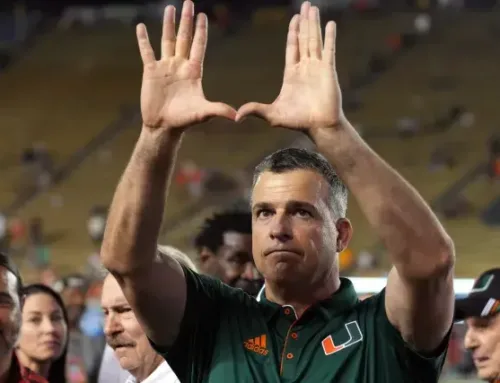
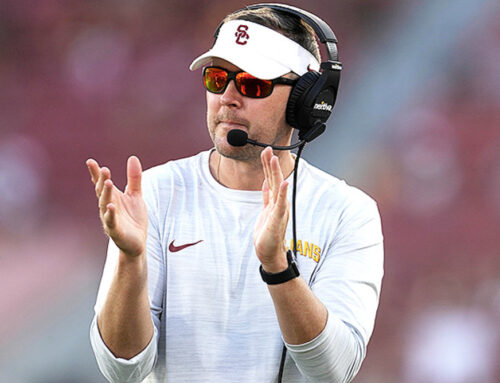
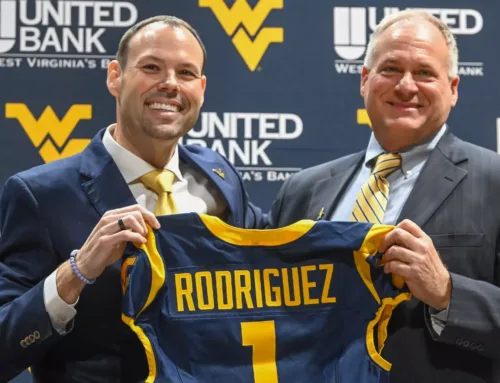
Good review — it’s pretty sad to look at some of those offense numbers. Your summary of the defense seemed spot on — death by a thousand paper cuts, especially not showing up for those 2nd and long plays
Very well written. Very depressing.
Stay engaged, this site is the only place where I find solace as in “misery loves…” good company. Thanks.